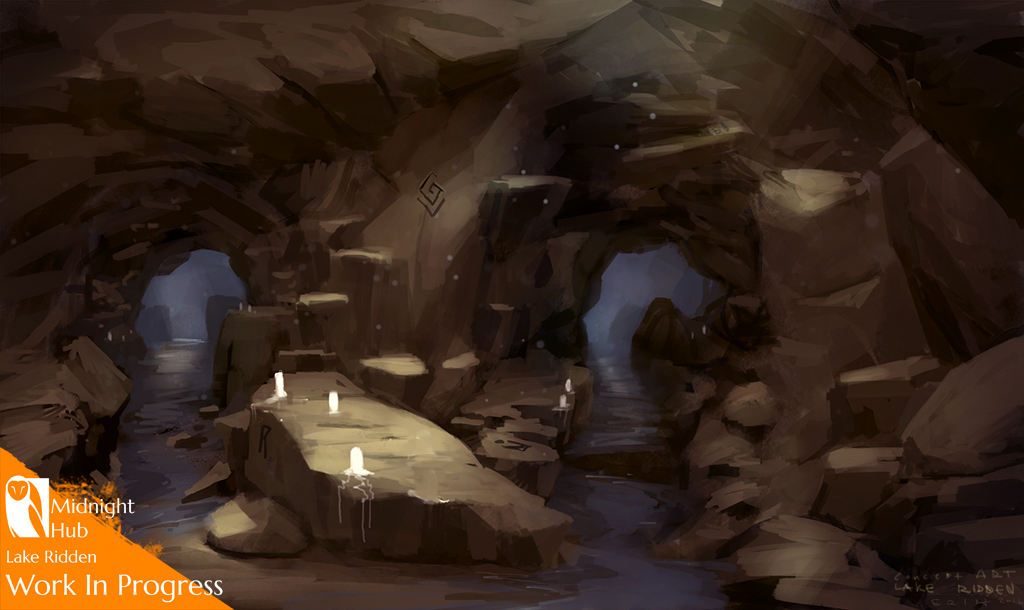As the creative director of Midnight Hub, I’m not only responsible for all code in the game, but also the game design and story. In this post, I hope to convey the way that we are designing Lake Ridden and how that might differ from other projects. Being such a small team gives us a lot of flexibility, but it also adds constraints as manpower available and a relatively short development period.
Game Concept & Main Story
What started the work on Lake Ridden was a meeting where the entire team sat down and were able to freely pitch game ideas. At this meeting, Sara pitched an idea called “Keymaster”, that would eventually evolve into Lake Ridden. The next step was for me to start creating the basic story outline for the game.
We decided to write the main story iteratively instead of starting out with a big, complete script since we wanted to tie it closely together with the game design, and also since it is very difficult to scope a project like this. Instead we created some milestones for the game (important key moments the player would experience), and started working on the backstory and what would happen in the game.

Much of the gameplay in Lake Ridden evolves around solving puzzles and exploring.
Main Investigatory Goals
Since we decided on making a mystery story of a sort, one of the first tasks was to figure out how the player would progress the story. How would player interactions work, how should the player learn the information and the what kind of story were we trying to tell?
Splitting The Game Up into Chapters
One of the most important thing from a development standpoint in Lake Ridden, was to split the game up into “chapters”. Where one chapter end and another begins are mostly transparent to the player, but it meant that we could easily work on one specific part of the game at a time. I imagine that this approach would be difficult in some games, but even in Lake Ridden, where the game world has a central hub, this worked really great!
Since we have to set up position and game state for development, this also makes it easier to test a specific point in the game.
White Boxing the Game
Last week, Sara wrote about our process for white boxing, and this process has been crucial in helping us quickly test game play concepts, not having to wait for artists to try new concepts. White boxing is not only a great project process for making the game, but can be applied to a lot of development areas as shown below!

White boxing levels and rooms of the game before building the final level art.
AI and Puzzles
While the art team starts creating content, programming and design start working on AI and making sure that the puzzles work the way we want them to. Having most of the game in boxes now allows us to add them directly into the world without waiting for our artists and it makes it very easy to quickly iterate on the different game elements. We are going to talk more about our AI in a later post.
Interactivity
An important thing in most games is that the player needs to be able to affect the world through actions. This will help make the player feel like part of the world instead of just being an observer. In action filled games, this comes easily since you can shoot on everything, but without a gun we needed to create other ways of interaction. These can include opening doors and drawers or pick up items for the player to examine. By making a separate pass over the game adding these actions, we can make sure that the pacing of the game feels great for the player.
Since we always have a runnable build of the game, we can easily do playtests weekly and see which areas we need to work more on. Making changes late in game productions is usually difficult but from day one we have made it a priority to primarily make assets that can easily be put in different parts of the game.
Lore
While we have been working on the rest of the game, we have also been writing the story. Writing the story can be split up into two parts, the first one is the content;what is the story we want to tell? The second one is to decide how to tell the story. Since we are making an investigatory game, we add a lot of clues and optional objects for the player to find and read/listen to. Most of the game is fleshed out at this point and it is easy for us to place clues and further improve the pacing.
In summary, splitting Lake Ridden up into chapters for the game development is a big success and is helping us make huge progress on the game! It will allow us to be agile with our development and continue to make the game better and better until release. I hope you enjoyed the post!
🙂
– Johan
